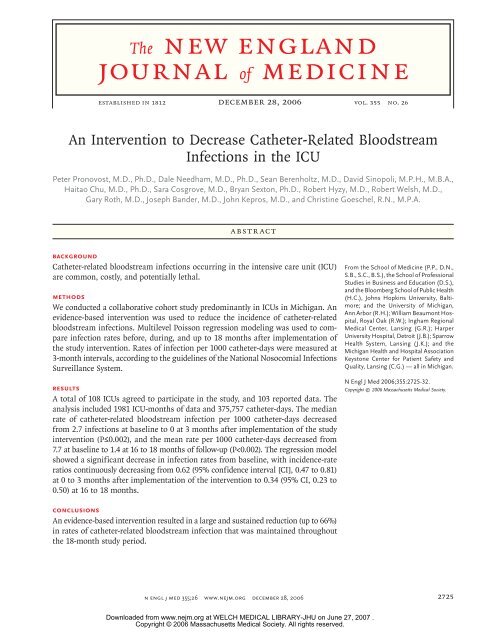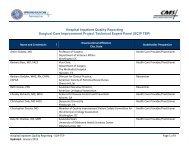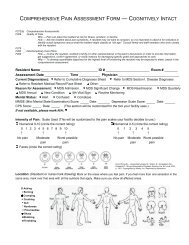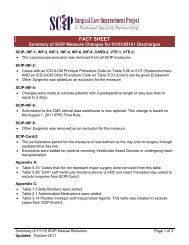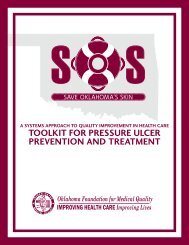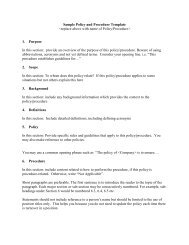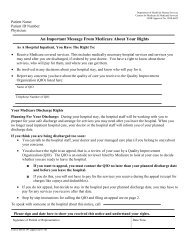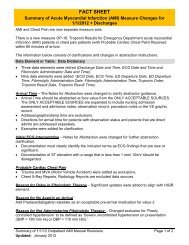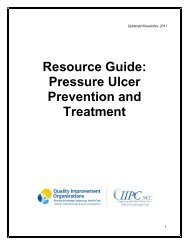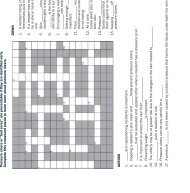The new england journal of medicine
The new england journal of medicine
The new england journal of medicine
Create successful ePaper yourself
Turn your PDF publications into a flip-book with our unique Google optimized e-Paper software.
<strong>The</strong> <strong>new</strong> <strong>england</strong><strong>journal</strong> <strong>of</strong> <strong>medicine</strong>established in 1812 december 28, 2006 vol. 355 no. 26An Intervention to Decrease Catheter-Related BloodstreamInfections in the ICUPeter Pronovost, M.D., Ph.D., Dale Needham, M.D., Ph.D., Sean Berenholtz, M.D., David Sinopoli, M.P.H., M.B.A.,Haitao Chu, M.D., Ph.D., Sara Cosgrove, M.D., Bryan Sexton, Ph.D., Robert Hyzy, M.D., Robert Welsh, M.D.,Gary Roth, M.D., Joseph Bander, M.D., John Kepros, M.D., and Christine Goeschel, R.N., M.P.A.A bs tr ac tBackgroundCatheter-related bloodstream infections occurring in the intensive care unit (ICU)are common, costly, and potentially lethal.MethodsWe conducted a collaborative cohort study predominantly in ICUs in Michigan. Anevidence-based intervention was used to reduce the incidence <strong>of</strong> catheter-relatedbloodstream infections. Multilevel Poisson regression modeling was used to compareinfection rates before, during, and up to 18 months after implementation <strong>of</strong>the study intervention. Rates <strong>of</strong> infection per 1000 catheter-days were measured at3-month intervals, according to the guidelines <strong>of</strong> the National Nosocomial InfectionsSurveillance System.ResultsA total <strong>of</strong> 108 ICUs agreed to participate in the study, and 103 reported data. <strong>The</strong>analysis included 1981 ICU-months <strong>of</strong> data and 375,757 catheter-days. <strong>The</strong> medianrate <strong>of</strong> catheter-related bloodstream infection per 1000 catheter-days decreasedfrom 2.7 infections at baseline to 0 at 3 months after implementation <strong>of</strong> the studyintervention (P≤0.002), and the mean rate per 1000 catheter-days decreased from7.7 at baseline to 1.4 at 16 to 18 months <strong>of</strong> follow-up (P
T h e n e w e ng l a nd j o u r na l o f m e dic i n eStatistical AnalysisBecause <strong>of</strong> the nonnormal distribution <strong>of</strong> the dataon catheter-related bloodstream infections, mediansand interquartile ranges were used to summarizethe data. Medians were compared withbaseline values with the use <strong>of</strong> a two-sample Wilcoxonrank-sum test. To explore the exposure–outcomerelationship, we used a generalized linearlatent and mixed model 18,19 with a Poisson distributionfor the quarterly number <strong>of</strong> catheter-relatedbloodstream infections. In the model, we used robustvariance estimation and included two-levelrandom effects to account for nested clusteringwithin the data, catheter-related bloodstream infectionswithin hospitals, and hospitals withinthe geographic regions included in the study. 18,20<strong>The</strong> addition <strong>of</strong> a third level <strong>of</strong> clustering for apotential ICU effect (catheter-related bloodstreaminfections within ICUs, ICUs within hospitals, andhospitals within the geographic regions) did notchange the results. We adjusted for the hospital’steaching status and bed size in the model and exploredinteractions between the effect <strong>of</strong> the studyintervention (modeled as a continuous variable)and teaching status and bed size. We conducteda sensitivity analysis <strong>of</strong> these results in which onlyICUs with continuous data, including baseline(preimplementation) data, were included. All reportedP values are two-sided; a P value <strong>of</strong> 0.05 orless was considered to indicate statistical significance.We used Stata s<strong>of</strong>tware (version 9.1) for theanalysis. <strong>The</strong> study was approved by the institutionalreview board <strong>of</strong> Johns Hopkins UniversitySchool <strong>of</strong> Medicine. Informed consent was waivedbecause the study was considered exempt fromreview.<strong>The</strong> AHRQ provided financial support for theKeystone ICU project but had no role in the designor conduct <strong>of</strong> the study; the collection, management,analysis, or interpretation <strong>of</strong> the data;the preparation, review, or approval <strong>of</strong> the manuscript;or the decision to submit the manuscriptfor publication. <strong>The</strong> MHA provided support forthe biannual statewide meetings but had no influenceon the design, implementation, analysis,or results <strong>of</strong> the study. <strong>The</strong> authors had full accessto the data and vouch for the accuracy and completeness<strong>of</strong> the data and the analysis.R esult sFive <strong>of</strong> 108 participating ICUs were excluded: 4 becausethey did not track or report catheter-relatedbloodstream infections, catheter-days, or both,and 1 because it merged with another participatingICU, so that the combined data were used inthe analysis. <strong>The</strong> data were obtained from 67 hospitals,<strong>of</strong> which 52% were teaching facilities. <strong>The</strong>types <strong>of</strong> ICU included medical, surgical, cardiacmedical or surgical, neurologic, and surgical traumaunits and one pediatric unit. <strong>The</strong> ICUs represented1625 (85%) <strong>of</strong> all ICU beds in Michigan.Of 34 hospitals in Michigan that did not participatein the study, 27 (79%) had fewer than 100beds; the total number <strong>of</strong> beds in the ICUs notincluded in the study was 268.Thus, 103 ICUs reporting data for 1981 ICUmonthsand 375,757 catheter-days were includedin the final analysis. <strong>The</strong> characteristics <strong>of</strong> theICUs according to the study period are summarizedin Table 1. Baseline data on catheter-relatedbloodstream infections at the participating ICUsTable 1. Characteristics <strong>of</strong> 103 Participating ICUs, According to the Period <strong>of</strong> Implementation <strong>of</strong> the Interventionto Reduce the Rate <strong>of</strong> Catheter-Related Bloodstream Infections.PeriodNo. <strong>of</strong> ICUsNo. <strong>of</strong>Catheter-Daysper Month Teaching Hospital No. <strong>of</strong> Bedsmedian(interquartile range) %median(interquartile range)March to May 2004* 40 154 (94–258) 83 404 (268–609)June to August 2004 35 146 (72–228) 57 336 (218–610)September to November 2004 17 181 (80–275) 59 299 (190–393)After November 2004 11 172 (48–279) 73 288 (181–917)* Baseline data were not collected by ICUs implementing the study intervention during the baseline (preimplementation)period.2728n engl j med 355;26 www.nejm.org december 28, 2006Downloaded from www.nejm.org at WELCH MEDICAL LIBRARY-JHU on June 27, 2007 .Copyright © 2006 Massachusetts Medical Society. All rights reserved.
Reducing Catheter-Related Bloodstream Infections in the ICUare summarized in Table 2, according to theteaching status and bed size <strong>of</strong> the hospitals.When the Keystone ICU project was launched, 13<strong>of</strong> the 67 hospitals (19%) included chlorhexidinein the central-line kits used in the ICUs. Six weeksafter the study letter was sent to CEOs at the 67participating hospitals, 56 (84%) stocked chlorhexidine,46 (69%) stocked the agent in the ICU, and43 (64%) stocked it in central-line carts.<strong>The</strong> total number <strong>of</strong> catheter-days changedlittle during the study. In ICUs that implementedthe study intervention during the 3 months (Juneto August 2004) after baseline data were collected(Table 1), the mean number <strong>of</strong> catheterdaysper month was 4779. During the follow-upperiod, the mean number <strong>of</strong> catheter-days permonth ranged from 4757 at 4 to 6 months afterimplementation <strong>of</strong> the intervention to 5469 at10 to 12 months after implementation.<strong>The</strong> overall median rate <strong>of</strong> catheter-relatedbloodstream infection decreased from 2.7 (mean,7.7) infections per 1000 catheter-days at baselineto 0 (mean, 2.3) at 0 to 3 months after implementation<strong>of</strong> the study intervention (P≤0.002) andwas sustained at 0 (mean, 1.4) during 18 months<strong>of</strong> follow-up (Table 3). A significant decreasewas observed in both teaching and nonteachinghospitals and in small hospitals (
T h e n e w e ng l a nd j o u r na l o f m e dic i n eTable 3. Rates <strong>of</strong> Catheter-Related Bloodstream Infection from Baseline (before Implementation <strong>of</strong> the Study Intervention) to 18 Months<strong>of</strong> Follow-up.*Study Period No. <strong>of</strong> ICUs No. <strong>of</strong> Bloodstream Infections per 1000 Catheter-DaysOverallTeachingHospitalNonteachingHospital
Reducing Catheter-Related Bloodstream Infections in the ICUbaseline data from ICUs that immediately implementedthe intervention when the project waslaunched could have created a measurement biasthat exaggerated the results. However, the infectionrates were collected and reported accordingto the guidelines <strong>of</strong> the NNIS by hospital infection-controlpractitioners who were independent<strong>of</strong> the ICU staff implementing the intervention.Furthermore, a sensitivity analysis showed littlechange in the association between the interventionand outcomes when only ICUs for whichcomplete data (including baseline data) were availablewere included.Third, data on the organisms causing catheterrelatedbloodstream infections were not collected,limiting insight into the mechanism <strong>of</strong> theobserved benefit. Fourth, we did not evaluatecompliance with the study intervention, becauselimited resources prevented observation <strong>of</strong> central-lineplacements. Fifth, we could not evaluatethe relative importance <strong>of</strong> individual components<strong>of</strong> the multifaceted intervention or <strong>of</strong> the safetycultureintervention. However, our goal was maximalimprovement <strong>of</strong> patient safety, and the studyprogram <strong>of</strong>fered the greatest probability <strong>of</strong> reducingcatheter-related bloodstream infections.Sixth, we did not obtain data on catheter-relatedbloodstream infection rates from nonparticipatingICUs. Nevertheless, the ICUs that participatedin the study accounted for 85% <strong>of</strong> ICU beds inMichigan. Last, we studied ICUs in only one state,which may limit the ability to generalize our findings.Nevertheless, a wide variety <strong>of</strong> types <strong>of</strong> hospitaland ICU were studied.In summary, catheter-related bloodstream infectionsare expensive, prevalent, and <strong>of</strong>ten fatal.As part <strong>of</strong> the Michigan statewide patient-safetyinitiative, we implemented a simple and inexpensiveintervention to reduce these infections in103 ICUs. Coincident with the intervention, themedian rate <strong>of</strong> infection decreased from 2.7 per1000 catheter-days at baseline to 0 within the first3 months after the implementation <strong>of</strong> the intervention.<strong>The</strong> benefit from the intervention wassustained, and there was a reduction in the rate<strong>of</strong> catheter-related bloodstream infection <strong>of</strong> 66%Table 4. Incidence-Rate Ratios for Catheter-Related Bloodstream Infections.*VariableStudy periodBaseline 1.00Incidence-Rate Ratio(95% CI) P ValueDuring implementation 0.76 (0.57–1.01) 0.063After implementation0–3 mo 0.62 (0.47–0.81) 0.0014–6 mo 0.56 (0.38–0.84) 0.0057–9 mo 0.47 (0.34–0.65)
Reducing Catheter-Related Bloodstream Infections in the ICUport, data summary from January 1992through June 2004, issued October 2004.Am J Infect Control 2004;32:470-85.5. Warren DK, Zack JE, Mayfield JL, et al.<strong>The</strong> effect <strong>of</strong> an education program on theincidence <strong>of</strong> central venous catheter-associatedbloodstream infection in a medicalICU. Chest 2004;126:1612-8.6. Sherertz RJ, Ely EW, Westbrook DM,et al. Education <strong>of</strong> physicians-in-trainingcan decrease the risk for vascular catheterinfection. Ann Intern Med 2000;132:641-8.7. Eggimann P, Harbarth S, ConstantinMN, Touveneau S, Chevrolet JC, Pittet D.Impact <strong>of</strong> a prevention strategy targeted atvascular-access care on incidence <strong>of</strong> infectionsacquired in intensive care. Lancet2000;355:1864-8.8. Cohran J, Larson E, Roach H, Blane C,Pierce P. Effect <strong>of</strong> intravascular surveillanceand education program on rates <strong>of</strong> nosocomialbloodstream infections. Heart Lung1996;25:161-4.9. Monitoring hospital-acquired infectionsto promote patient safety — UnitedStates, 1990–1999. MMWR Morb MortalWkly Rep 2000;49:149-53. [Erratum,MMWR Morb Mortal Wkly Rep 2000;49:189-90.]10. Berenholtz SM, Pronovost PJ, LipsettPA, et al. Eliminating catheter-relatedbloodstream infections in the intensivecare unit. Crit Care Med 2004;32:2014-20.11. Reduction in central line-associatedbloodstream infections among patients inintensive care units — Pennsylvania, April2001–March 2005. MMWR Morb MortalWkly Rep 2005;54:1013-6.12. Warren DK, Cosgrove SE, DeikemaDJ, et al. A multicenter intervention to preventcatheter-associated bloodstream infections.Infect Control Hosp Epidemiol2006;27:662-9.13. Pronovost P, Berenholtz S, Dorman T,Lipsett PA, Simmonds T, Haraden C. Improvingcommunication in the ICU usingdaily goals. J Crit Care 2003;18:71-5.14. Berenholtz SM, Milanovich S, FairclothA, et al. Improving care for the ventilatedpatient. Jt Comm J Qual Saf 2004;30:195-204.15. Pronovost P, Weast B, Rosenstein B,et al. Implementing and validating a comprehensiveunit-based safety program.J Patient Saf 2005;1:33-40.16. Pronovost PJ, Weast B, Bishop K, et al.Senior executive adopt-a-work unit: a modelfor safety improvement. Jt Comm J QualSaf 2004;30:59-68.17. Pronovost P, Goeschel C. ImprovingICU care: it takes a team. Healthc Exec2005;20:14-6, 18, 20 passim.18. Rabe-Hesketh S, Skrondal A. Multileveland longitudinal modeling usingStata. College Station, TX: Stata Press,2005.19. Skrondal A, Rabe-Hesketh S. Generalizedlatent variable modeling: multilevel,longitudinal, and structural equation models.Boca Raton, FL: Chapman & Hall/CRC,2004.20. Panageas KS, Schrag D, Riedel E,Bach PB, Begg CB. <strong>The</strong> effect <strong>of</strong> clustering<strong>of</strong> outcomes on the association <strong>of</strong> procedurevolume and surgical outcomes. AnnIntern Med 2003;139:658-65.21. Leape LL, Berwick DM. Five years afterTo Err Is Human: what have we learned?JAMA 2005;293:2384-90.22. Altman DE, Clancy C, Blendon RJ. Improvingpatient safety — five years afterthe IOM report. N Engl J Med 2004;351:2041-3.23. Wachter R. <strong>The</strong> end <strong>of</strong> the beginning:patient safety five years after ‘To Err IsHuman.’ Health Aff (Millwood) 2004;23:Suppl 2 Web Exclusives:W4-534–W4-545.24. Brennan TA, Gawande A, Thomas E,Studdert D. Accidental deaths, saved lives,and improved quality. N Engl J Med 2005;353:1405-9.25. Warren DK, Quadir WW, HollenbeakCS, Elward AM, Cox MJ, Fraser VJ. Attributablecost <strong>of</strong> catheter-associated bloodstreaminfections among intensive carepatients in a nonteaching hospital. CritCare Med 2006;34:2084-9.Copyright © 2006 Massachusetts Medical Society.full text <strong>of</strong> all <strong>journal</strong> articles on the world wide webAccess to the complete text <strong>of</strong> the Journal on the Internet is free to all subscribers. To use this Web site, subscribers should goto the Journal’s home page (www.nejm.org) and register by entering their names and subscriber numbers as they appear ontheir mailing labels. After this one-time registration, subscribers can use their passwords to log on for electronic access to theentire Journal from any computer that is connected to the Internet. Features include a library <strong>of</strong> all issues since January 1993and abstracts since January 1975, a full-text search capacity, and a personal archive for saving articles and search results <strong>of</strong>interest. All articles can be printed in a format that is virtually identical to that <strong>of</strong> the typeset pages. Beginning 6 months afterpublication, the full text <strong>of</strong> all Original Articles and Special Articles is available free to nonsubscribers who have completed abrief registration.2732n engl j med 355;26 www.nejm.org december 28, 2006Downloaded from www.nejm.org at WELCH MEDICAL LIBRARY-JHU on June 27, 2007 .Copyright © 2006 Massachusetts Medical Society. All rights reserved.
New England Journal <strong>of</strong> MedicineCORRECTIONAn Intervention to Decrease Catheter-RelatedBloodstream Infections in the ICUAn Intervention to Decrease Catheter-Related Bloodstream Infectionsin the ICU . In the first paragraph under the ``Measurement and Categorization<strong>of</strong> Data´´ heading (page 2727), the sixth sentence shouldhave read, ``We defined a central catheter as a catheter that endsat or near the heart or in a great vessel close to the heart, whichincluded peripherally inserted central catheters, and the teams wereexplicitly instructed to count the use <strong>of</strong> multiple lines in one patientas 1 catheter-day, in accordance with the NNIS guidelines,´´ ratherthan ``great vessel close to the heart, and the teams were explicitlyinstructed to exclude peripherally inserted central catheters and tocount the use.´´ <strong>The</strong> text has been corrected on the Journal’s Website at www.nejm.org.N Engl J Med 2007;356:2660-aDownloaded from www.nejm.org at WELCH MEDICAL LIBRARY-JHU on June 27, 2007 .Copyright © 2006 Massachusetts Medical Society. All rights reserved.


